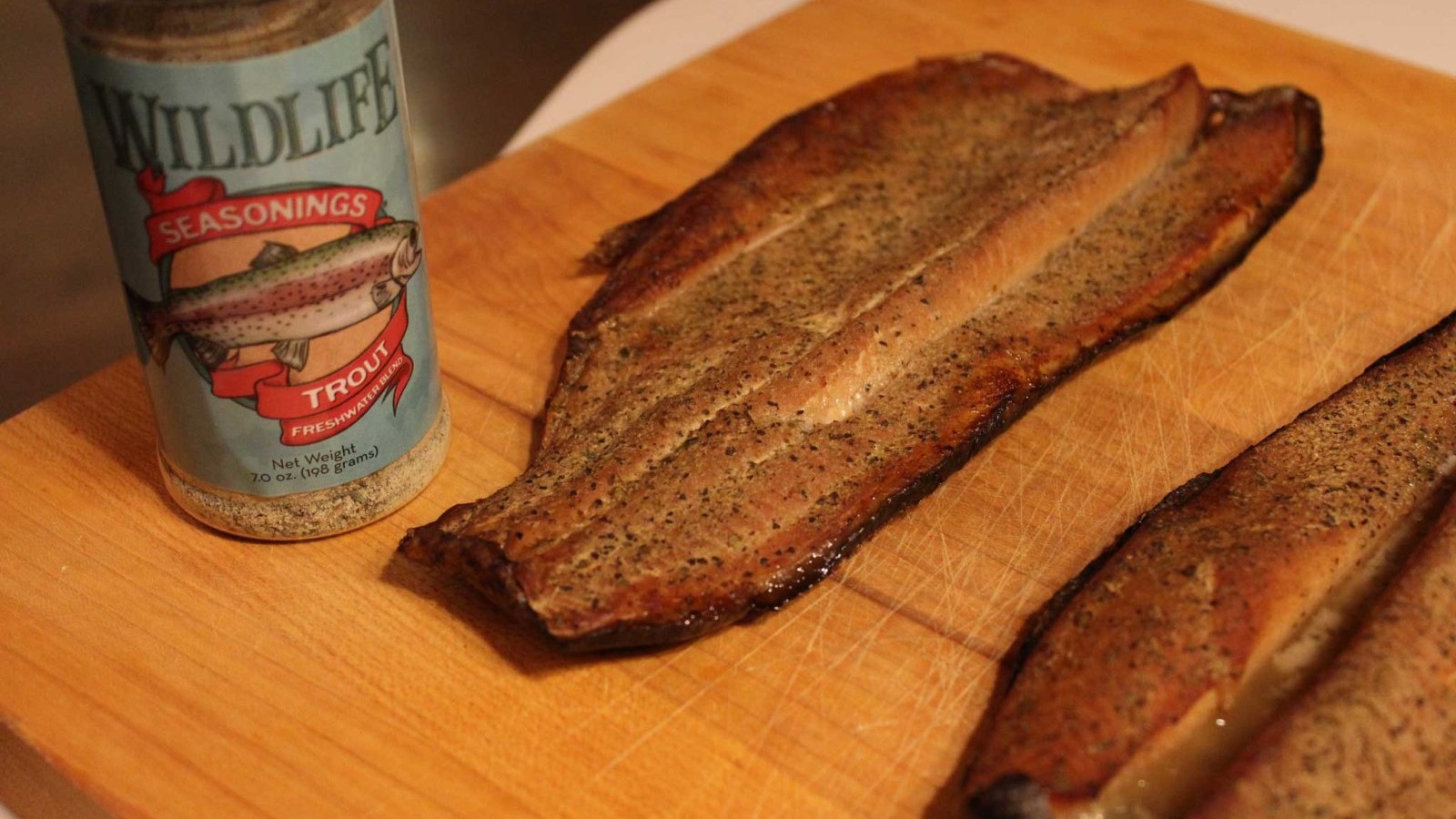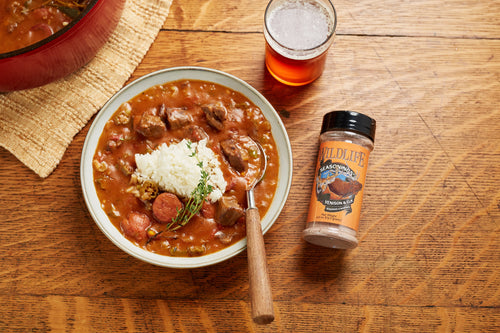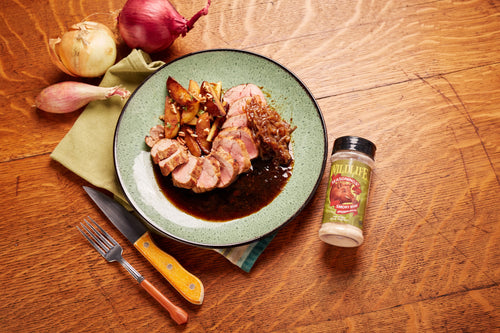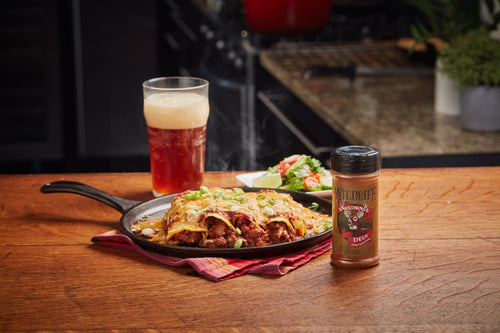Smoked Trout Recipe
This simple smoked trout recipe produces juicy and flavorful trout whether you are cooking whole trout or fillets. Works great with trout, steelhead,
lake trout or even Salmon.
Wildlife Seasonings Smoked Trout
Rated 5.0 stars by 1 users
Category
Freshwater Fish
Servings
2-6
Prep Time
15 minutes
Cook Time
90-180 minutes
Some of my fondest memories as a child are of spending time with my Grandparents who lived on Lake Taneycomo in southwestern Missouri. I would spend weeks at a time with them over the summers including many days on the water with by Grandfather fishing for the lake's rainbow and brown trout. We would bring home smaller "smoking size" trout to smoke on his Little Chief electric smoker. I wasn't a big fan of eating trout back then, but I did love his smoked trout. I wish I would have paid more attention to his technique and recipe as a kid but I have attempted to replicate it here. I do know that he saltwater brined / marinated his trout first (rather than a dry brine), and then smoked them low and slow until they had a great smoky taste, stayed juicy, and flaked easily off the bones.
This recipe will work well for rainbow trout, brown trout, brook trout, etc. Wild caught or domestic / store bought trout will all smoke similarly. And you could actually use this technique on steelhead, lake trout or salmon. Works for either whole trout or fillets, with adjustments on the amount of time on the smoker depending on the size. You will want to leave the skin on, to help hold the moisture.
You will want to kick things off with a wet brine of 50/50 salt/brown sugar in water. I dissolve the salt and brown sugar in a little bit of warm water in an extra large zip bag and then add cold water to cover the trout. This goes in the fridge on top of a platter or pan, just in case the bag leaks. You can also brine in a non-reactive bowl or casserole dish, you just want to make sure that the trout is covered with brine. Flip the trout over occasionally to make sure the brine is penetrating all of the fish. Marinade from 2 hours to overnight depending on the size of the fish. The fillets in the photo were brined for 3 hours and that seemed to work well, not too salty.
After marinating, rinse the trout in cool water and pat dry with a paper towel. Now here is a part that many skip, but it is important; lay the fish on a wire rack over a baking sheet flesh side up and put back in the fridge uncovered for another 2-3 hours. This will dry out the surface and form what is called a pellicle. This sticky surface helps the smoke adhere to the fish. If you are cooking whole trout you will want to prop open the cavity with a few toothpicks to make sure the air gets to the surface of the flesh, and keep them propped open for the smoking process.
Next pull them out of the fridge and rub with Wildlife Seasonings Trout Freshwater Blend, which adds the savory flavor of black pepper, Mediterranean herbs and garlic.
Now you are ready for the smoker. For smokes like this one that require holding a lower temp, I prefer to use my Masterbuilt electric smoker rather than my charcoal Weber Smokey Mountain. Not that a charcoal smoker won't work, I just like the ease of keeping the lower temp with the electric smoker in this instance. But, any smoker like a Traeger, Bradley, Pit Boss, Little Chief or Camp Chef that can keep the temp down below 200 degrees will work well. I place my fillets directly on the smoker rack, but if you have whole trout you can hang them by the gills. If using the racks oil them first so that the skin does not stick. I add water to the water pan to help hold the moisture in the fish.
I used apple wood for this smoke but you can use any mild smoking wood like alder, cherry, or maple. For smoking fish I like to start my smoker temp lower at 180 degrees and bump it up 10 degrees each hour (if you can avoid it, don't go over 225). This slower ramp up will help in keeping that white protein called albumin from rising to the surface of the meat as it does when cooked at a higher temperature. Smoke times will vary from 1.5 - 3 ours depending on the thickness of your trout. Use an probe or instant read thermometer and pull at a temperature of 145 degrees fahrenheit.
The resulting smoked trout can be served hot or chilled and works great for dishes such as this tasty looking Smoked Trout Dip recipe:
Smoked Trout Dip Recipe
We would love to hear from you. In the comments below let us know your favorite way to cook trout.
Steve B

Ingredients
-
1.5 - 2 quarts water or enough to cover the trout
-
Wildlife Seasonings Trout Freshwater Blend
Directions
Combine the salt and brown sugar in an extra large zipper plastic bag or non-reactive dish and dissolve with a bit of warm water.
Add cold water to the bag and add the trout so that they are submerged in the brine.
Brine the trout in the saltwater and brown sugar brine in the refrigerator from 2 hours to overnight depending on the thickness of the fish.
Rinse the trout in cold water and pat dry.
Place the trout flesh side up on a wire rack on top of a baking sheet and put back In the fridge, uncovered for 2-3 hours in order to form a pellicle on the surface. If using whole fish prop them open with a few toothpicks so air circulates through out.
Add water to your smoker water pan if it is equipped with one and oil your smoker racks so that the skin does not stick.
Pre-heat the smoker to 180 degrees fahrenheit and add your smoking wood/pellets of choice. Milder woods work well, like apple, alder, cherry or maple.
Add the trout to the smoker being sure to keep some space between them for air and smoke circulation. They can either be placed on the racks or hung by their gills if you are smoking whole trout.
Each hour bump up the temparature on the smoker by 10 degrees and turn/rotate your smoker racks so that the trout smoke evenly.
Use a meat temperature probe or start checking temperature for doneness with an instant read thermometer at 1 1/2 hours and check every half hour from there. You want an internal temperature 145 degrees farenheight.
Remove from the smoker and serve warm as a main dish or chill for use on crackers or in smoked trout dip.
Recipe Note
Cooking times may vary. Overcooking will result in dry fish. Do not consume raw or undercooked fish.




0 comments